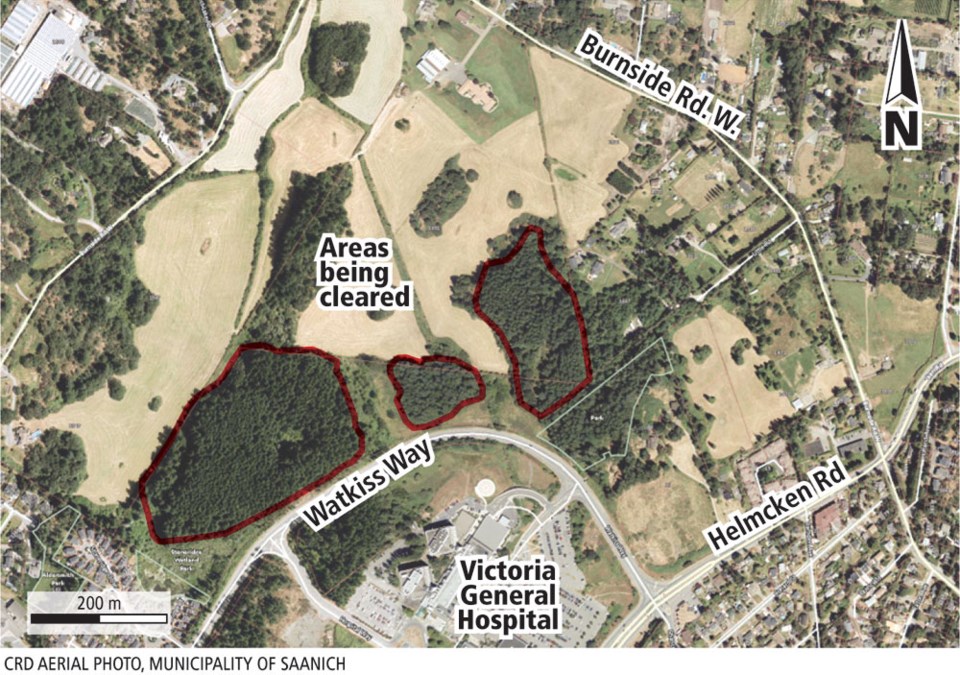The cutting down of nearly 5,000 trees in a long-standing greenbelt off Watkiss Way in Saanich is underway as property owner Allen Vandekerkhove prepares to grow hay on the site.
It’s a permitted use for the property, which is part of B.C.’s Agricultural Land Reserve.
Saanich issued a tree removal permit on Oct. 15 and Vandekerkhove said Thursday that about 200 trees have already come down. The trees are considered second growth and include primarily Douglas fir, western red cedar and grand fir.
The removal is ongoing on 24 acres of a 30-acre site at 1651 Burnside Rd. W. bordering Watkiss near Victoria General Hospital.
Vandekerkhove said he bought the parcel a couple of years ago. It is adjacent to a much larger property he has owned since 1976.
Five thousand is a lot of trees, but “I’m a farmer — what do I do?” he asked. He held off cutting the trees while his property was under consideration for a sewage treatment plant that would have been hidden in the forested area.
“But obviously, the council of Saanich decided against us. We put in a $100,000 proposal to Saanich for a treatment plant and they didn’t even come and look at it,” he said.
“Then my only choice is just to keep farming.”
Frank Leonard, chairman of the Agricultural Land Commission, said that clearing trees in the Agricultural Land Reserve for farm uses is permitted by provincial regulation, and noted that “most farmland today was once covered with trees.”
Vandekerkhove said he has already contracted the sale of the wood.
Saanich council voted 5-4 against the sewage treatment plant proposal in June, and then reconsidered the issue in July at the request of Mayor Richard Atwell. It lost on a tie vote and was not forwarded to the Capital Regional District for consideration.
Vandekerkhove’s tree removal decision did not come before Saanich council. The mayor could not be reached for comment.
“While I am always disappointed to see healthy tree loss in Saanich, it is my understanding that this is completely legal and within the landowner’s purview as he intends to grow hay,” said Coun. Colin Plant.
Tree removal for agriculture activity is considered a normal farm practice, said Coun. Susan Brice.
“The issuance of a permit for such activity is an administrative function. … For farm land to be productive it is frequently necessary for the land owner to seek permission for tree removal.”
Vandekerkhove first applied to remove the trees in October 2014, but Saanich staff requested verification of the specific areas to be cleared and confirmation that soils there would support agricultural use, said parks director Doug Henderson.
Saanich heard nothing more until last month when a second application that met the conditions was received.
In keeping with Agricultural Land Reserve regulations, the application included a sworn affidavit that the land will be used for hay production.
Henderson said the removal of 4,900 trees will be “the biggest by far” in the last 10 to 20 years in Saanich, with virtually all the trees on the property chopped down.
Stumps will not be burned on site but mechanically removed, said chief administrative officer Andy Laidlaw.
Marlene Todd, vice-president of the Residents Association of Strawberry Vale, Marigold and Glanford, was not aware of the coming cut and said: “Oh my God, I can’t believe he got a permit for that.”
Todd said it doesn’t fit in with the emphasis Saanich puts on preserving its tree canopy.
“I can’t speak for everybody, but generally I think people would not be too happy about seeing 5,000 trees coming down,” Todd said.
“My gosh, that’s terrible.”
Jack Mar, co-chairman of the Saanich Peninsula Agricultural Commission, said there is a shortage of hay, given that hot summer weather did not allow enough growth for the usual second cut.
A first-cut bale of hay sells for roughly $8 to $9, he said.



